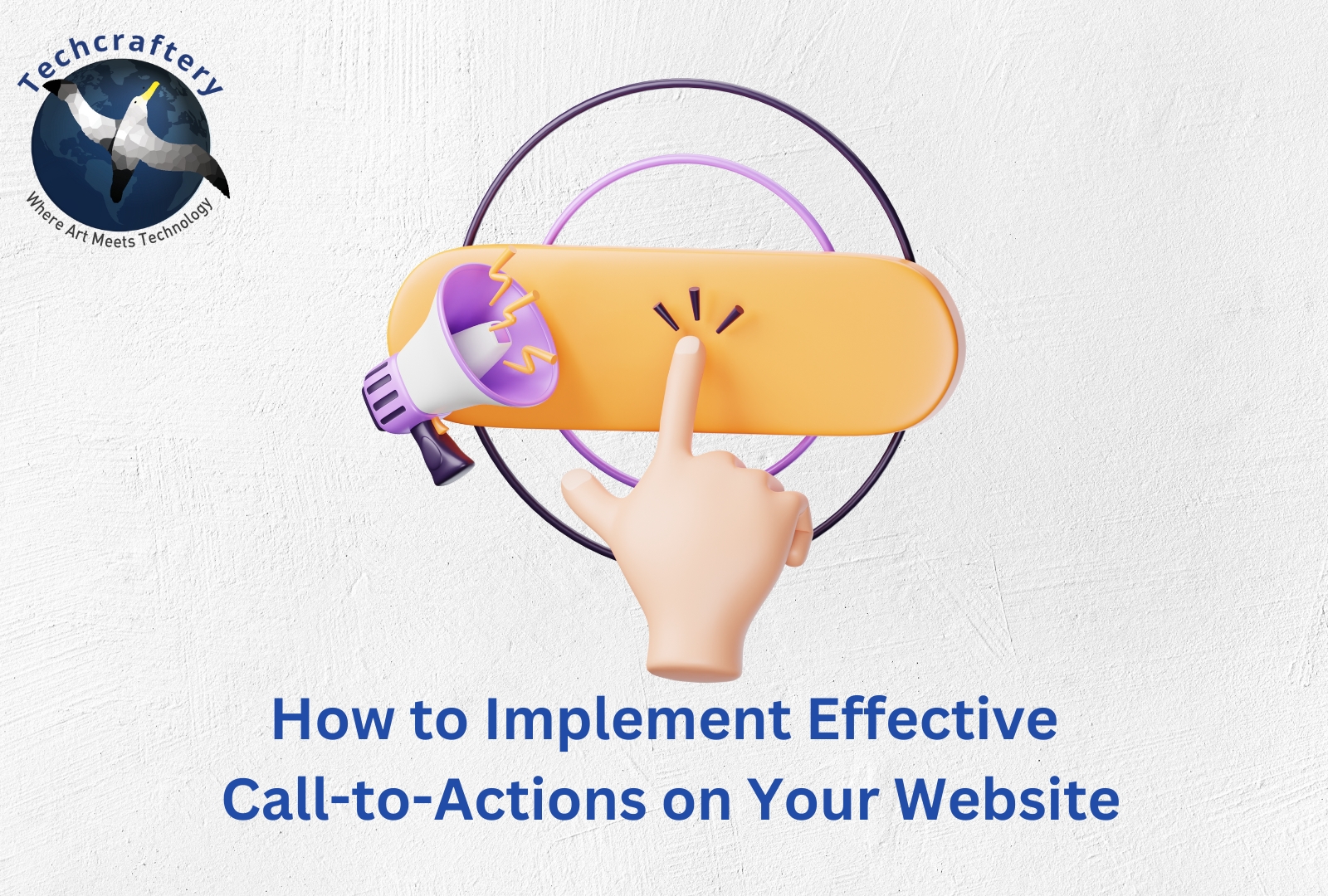Call-to-actions (CTAs) are a vital part of any website. They guide users on what to do next, whether it’s signing up for a newsletter, making a purchase, or contacting you for more information. Without effective CTAs, visitors may leave your website without taking the desired action. This article explores how to implement effective CTAs that engage users and lead them toward your goals.
1. Understanding the Importance of Call-to-Actions
A call-to-action is a prompt on a website that encourages users to take a specific action. CTAs can take various forms, such as buttons, links, or forms, and they often include short, persuasive text like “Sign Up,” “Get Started,” or “Learn More.” They play a crucial role in:
- Converting visitors into leads or customers
- Improving user experience
- Guiding users through the sales funnel
For example, if you’re running an e-commerce website, your goal may be to increase sales. A well-designed CTA like “Shop Now” can drive users to your product pages.
2. Defining Your CTA’s Objective
Before you create a CTA, it’s essential to define its objective. Ask yourself what action you want users to take when they visit your website. Here are some common objectives for CTAs:
- Lead Generation: Encouraging visitors to fill out a form in exchange for something valuable like an ebook or newsletter subscription.
- Sales: Directing visitors to your product or service pages.
- Engagement: Encouraging users to share your content, comment, or interact with your brand.
- Navigation: Helping users explore your website by directing them to specific pages.
Clear objectives will help you design more focused and effective CTAs.
3. Types of Call-to-Actions
There are many different types of CTAs depending on the action you want your visitors to take. Some common types include:
3.1. Lead Generation CTAs
These are designed to capture user information in exchange for something valuable, such as an ebook, webinar access, or newsletter sign-up. A typical lead generation CTA might say, “Download Now” or “Subscribe for Free Tips.”
3.2. Sales CTAs
For e-commerce sites, sales CTAs are designed to drive product purchases. Examples include “Shop Now,” “Add to Cart,” or “Start Your Free Trial.” These CTAs need to be clear and compelling to prompt users to make a purchase.
3.3. Engagement CTAs
These encourage users to engage with your content, whether by commenting, sharing, or interacting in some other way. Examples include “Leave a Comment,” “Share on Social Media,” or “Tell Us Your Thoughts.”
3.4. Event Promotion CTAs
These CTAs are designed to get users to sign up for events such as webinars, workshops, or conferences. Examples include “Register Now” or “Save Your Spot.”
3.5. Social Media CTAs
For driving traffic to social platforms or increasing follower count, you might use “Follow Us on Instagram” or “Join the Conversation.”
4. Writing Effective CTA Text
The text of your CTA is critical because it communicates what users should expect when they click. Here’s how to make your CTA text effective:
4.1. Use Action-Oriented Language
Your CTA should include action verbs like “download,” “subscribe,” “get,” “start,” or “learn.” These words push users toward taking action. For instance, instead of “Our Services,” a better CTA might be “Explore Our Services.”
4.2. Be Clear and Specific
The CTA should clearly describe the action. For example, if you’re offering a free ebook, use “Download Your Free Ebook” instead of just “Download.” This specificity sets clear expectations for users.
4.3. Create a Sense of Urgency
Adding urgency to your CTA can encourage users to take immediate action. Phrases like “Limited Time Offer,” “Get Started Now,” or “Don’t Miss Out” can push users to act without delay.
4.4. Focus on Benefits
Instead of focusing on what the user has to do, emphasize what they will gain. For example, instead of “Subscribe to our newsletter,” try “Get Weekly Tips Straight to Your Inbox.”
5. Design Tips for Effective CTAs
Visual design plays a crucial role in how effective your CTA is. Here are some design tips:
5.1. Button Color and Contrast
The CTA button should stand out on the page. Use contrasting colors that draw the user’s attention without clashing with your website’s color scheme. For example, if your website has a blue background, a bright orange CTA button will stand out.
5.2. Size Matters
The size of your CTA button should be large enough to be easily noticeable but not so big that it looks spammy. A good rule is to make the button slightly larger than surrounding elements.
5.3. White Space
Leave enough white space around the CTA to make it stand out. A crowded layout can make your CTA less noticeable. Clear, uncluttered space around the button helps it pop.
5.4. Placement of CTAs
Place your CTAs where users are most likely to engage with them. Typically, CTAs perform well above the fold (in the top section of a webpage) and at the end of blog posts or product descriptions. You can also use them in sidebars or as sticky buttons that follow the user as they scroll.
6. Testing and Optimizing Your CTAs
To ensure your CTAs are as effective as possible, regularly test and optimize them. Here’s how:
6.1. A/B Testing
A/B testing involves creating two versions of a CTA and testing them with your audience to see which performs better. You can test variations in text, color, placement, or size. For example, try testing a “Sign Up Now” button against a “Get Started” button to see which drives more sign-ups.
6.2. Analyze Click-Through Rates (CTR)
Monitor how often users click your CTA (click-through rate) compared to how many see it. Low CTRs indicate that the CTA may not be compelling enough, and changes in design or text may be needed.
6.3. Monitor Conversion Rates
Ultimately, the goal of a CTA is conversion. If users are clicking your CTA but not completing the desired action (like filling out a form or making a purchase), the problem may be on the page that follows the CTA.
7. Mobile Optimization for CTAs
In today’s digital landscape, mobile optimization is key. More users are browsing and shopping on mobile devices, so your CTAs must be mobile-friendly:
7.1. Responsive Design
Ensure that your CTA buttons adjust according to the screen size. A button that looks good on a desktop might be too small or too big on a mobile device.
7.2. Easy to Click
Mobile users navigate with their fingers, so the CTA button should be big enough to tap easily. A common recommendation is at least 44×44 pixels for touch targets.
7.3. Placement on Mobile
Mobile users scroll more than desktop users, so place your CTAs in locations that make sense for a mobile experience. A common strategy is to include a sticky CTA button at the bottom of the screen, making it easy to access at any time.
8. Using Multiple CTAs
Depending on your website’s layout and goals, using multiple CTAs can be effective. However, be cautious about overloading your page with too many choices, as it can confuse users. Here’s how to balance multiple CTAs:
8.1. Hierarchy of CTAs
If you use multiple CTAs, create a hierarchy. For example, your primary CTA might be “Buy Now,” but secondary CTAs like “Learn More” or “Add to Wishlist” can provide additional options without diluting the focus.
8.2. Align CTAs with Different Stages of the Buyer’s Journey
Different users will be at different stages of the buyer’s journey when they visit your website. Someone just learning about your brand might prefer a “Learn More” CTA, while a returning customer may be ready to “Buy Now.” Offering multiple CTAs allows you to cater to different users’ needs.
9. Common Mistakes to Avoid with CTAs
Some common mistakes can weaken the effectiveness of your CTAs:
9.1. Being Too Vague
CTAs that lack clarity or specificity, such as “Click Here” or “Submit,” may not give users enough information about what will happen when they click. Instead, make sure the CTA describes the action clearly.
9.2. Poor Placement
Placing your CTA in a location where it’s not easily seen can result in missed opportunities. Make sure it’s visible and placed strategically on the page.
9.3. Overloading the User
Too many CTAs can overwhelm users. Stick to one or two primary actions on each page to keep the experience simple and clear.
10. Examples of Effective CTAs
Example 1: Dropbox
Dropbox uses a simple and effective CTA on their homepage: “Sign up for free.” The language is clear, there’s an immediate benefit (it’s free), and the button stands out against a plain background.
Example 2: Netflix
Netflix uses the CTA “Join Free for a Month,” creating urgency and value by offering something for free. It clearly explains the benefit and urges users to try the service risk-free.





